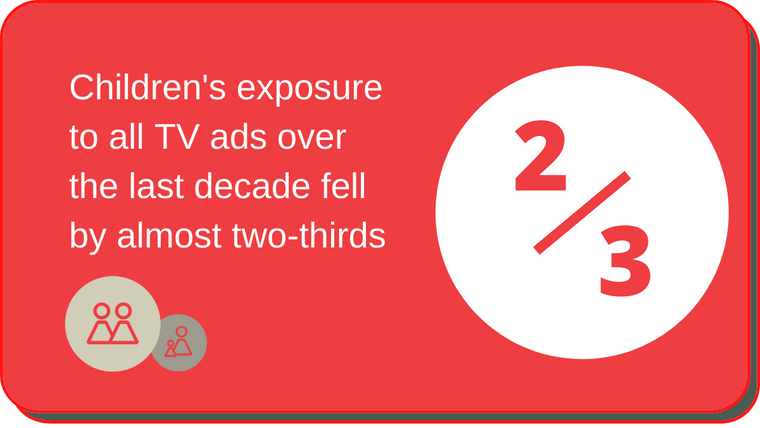
Children’s exposure to gambling and alcohol ads on TV has decreased significantly over the last decade, we can reveal.
- Under-16s exposure to TV ads for alcohol decreased by three quarters since 2010
- Exposure to gambling ads on TV decreased by over a quarter
- For the first time, statistics are broken down by nation, providing a fuller picture of children’s experiences across the UK
As part of our commitment to protecting vulnerable audiences from potential harms, we conduct regular monitoring of ads, in particular those for age-restricted products, to help identify trends and ensure our tough scheduling restrictions are working to limit appropriately, in this case children’s, exposure to them. The findings of this report show that children are seeing fewer ads for gambling and alcohol products on TV, in a continuing downward trend.
For the first time, we’ve also broken the data down by nation, revealing differences across the UK for a more complete picture.
Overall, between 2010 and 2021:
- Children’s exposure to all TV ads in the period fell by almost two-thirds, from 226.7 ads per week in 2010 to 82.8 ads per week in 2021. They also saw fewer TV ads than adults, around one ad for every four seen by adults.
- Children’s exposure to alcohol advertising on TV decreased by three-quarters, from an average of 3.2 ads per week in 2010 to 0.8 ads per week in 2021. This is a faster rate of decline than children’s exposure to all TV ads.
- Exposure to gambling ads on TV over the same period decreased by just over a quarter from an average of 3.0 ads per week in 2010 to 2.2 ads per week in 2021. Exposure to gambling ads relative to adults’ has fallen year-on-year, from 36.0% in 2010 to 15.4% in 2021.
Statistics by nation:
England
As with all four nations, children in England are seeing many fewer TV ads than in the past, from an average of 227.5 ads per week in 2013 – the peak of children’s exposure to TV ads - down to 81.6 ads in 2021, a decrease of 64%.
Children in England were exposed to the least amount of alcohol ads on TV per week; from 3.1 on average in 2010 to 0.8 in 2021. Under-16s saw an average of 2.1 gambling ads on TV per week in 2021, down from an average of 2.9 in 2010.
Scotland
Under-16s in Scotland saw the most TV ads overall, though the rate has still fallen dramatically: from 225.1 ads on average per week in 2013, the exposure rate has decreased to 92.8 ads.
Children in Scotland saw a drop in exposure to alcohol ads on TV, from 3.4 on average per week in 2010 to 0.9 per week in 2021. Exposure to TV gambling ads fell from 3.5 per week in 2010 to 2.8 in 2021.
Northern Ireland
Children’s exposure to all TV ads fell the most in Northern Ireland. From the peak in 2013 at 281.6 ads a week, the rate of exposure fell 79% to an average of 59 ads per week, the lowest rate of exposure in the UK. Under-16s in Northern Ireland watch the least amount of television overall, at an average of 4.2 hours per week.
Children in Northern Ireland saw the biggest decrease in exposure to alcohol ads, from 5.2 ads on average per week in 2010 down to 1 per week in 2021.
Under-16s in Northern Ireland saw the fewest gambling ads, from an average of 3.5 per week in 2010 down to 1.4 per week in 2021. This was the strongest rate of decline in exposure of all four nations.
Wales
Children in Wales watched the most television in 2021, though the amount has still fallen significantly; from an average of 19.9 hours per week in 2010 to 5.9 in 2021.
Under-16s in Wales exposure to TV alcohol ads declined; from 3.7 ads per week on average in 2010 to 1 per week in 2021. They also saw the most ads on TV for gambling products, though still declining; from 3.9 ads in 2010 down to 3.2 ads in 2021.
The 100 Children Report
While the continued decline in children’s exposure to TV ads is encouraging, we know that a lot of that is down to changing media habits. That’s why we have been conducting specific project work to gain a fully rounded picture of children’s exposure to ads. We’ve used cutting-edge Avatar technology that simulates children’s online profiles to find out what ads they’re exposed to on the internet. We’ve run quarterly CCTV-style monitoring sweeps to find where age-restricted ads have broken our rules. And we’ve commissioned new research with our next study, The 100 Children Report. Working with a panel of 100 children aged 11-17, from across the UK, we will be able to identify and take action against age-restricted ads served inappropriately to children’s websites and their social media accounts. Building on a study we undertook in 2013, this piece of work will help provide a crucial insight into the real-world experiences of children’s exposure to and interaction with online ads.
Guy Parker, Chief Executive of the ASA, said:
“Our latest report confirms the ongoing decline in children’s exposure to ads for age-restricted products, which is what our rules are designed to achieve. But of course that’s not the full story. Children’s media consumption habits are changing significantly, which is why we’re also focussed on protecting them online. Later this year, we’ll publish our findings on the ads they are seeing across the internet and social media as part of our zero-tolerance approach to age-restricted ads being served to children."
Read the full report on Children's Exposure to Age-restricted TV ads.
More on
-
Keep up to date
Sign up to our rulings, newsletters and emargoed access for Press. Subscribe now.


